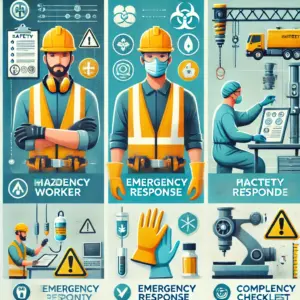High-risk work environments include manufacturing factories, construction sites, confined spaces, working at heights, and healthcare settings, among many others.
In these settings, workers are exposed to major dangers, such as heavy machinery, toxic materials, heights, or diseases.
For them, safety training isn’t an option; it’s a must-have to ensure they live through every workday without accidents or injuries while boosting productivity.
If you’re still curious why safety training is required for them, let’s get started here!
1. Prevents Workplace Injuries and Accidents
Statistics show that in the past 10 years, 1880+ traumatic injury fatalities happened in Australian workplaces, and 1165100+ workers made one serious workers’ compensation claim.
With proper safety training for high-risk environment workers, you can reduce the number of injuries and fatal accidents. It ensures everyone is properly trained and has the right knowledge to identify hazards and take the right actions to prevent accidents.
For instance, construction workers learn to correctly implement fall protection equipment and operate heavy machinery safely. Healthcare employees can learn to reduce exposure to pathogens with standard infection control protocols.
2. Improves Hazard Awareness
Safety training also equips workers with all relevant technical knowledge that raises their awareness of all sorts of hazards in their environment.
Workers learn to be more watchful of their surroundings and identify new and at-the-moment risks that weren’t present during identifications.
For instance, workers with a confined space ticket from a reputable institution can identify when a confined space has inadequate oxygen, atmospheric hazards, or chances of explosion. They’ll be able to signal their team members and get everyone out of there without any casualties.
On the other hand, someone working at heights training can identify faulty scaffolds or electrical cord issues. Thus, improved awareness ensures that everyone is safe.
3. Ensures Legal and Regulatory Compliance
Safety training is mandatory for most high-risk jobs. According to Safe Work Australia, all workers must have a valid and current high-risk work license for their specific job.
Non-compliance with these regulations can attract legal troubles, financial penalties, and even businesses getting suspended temporarily or closed permanently.
By keeping your workers updated with the latest safety training and retraining them before their license expires, you can meet all legal and regulatory compliance needs. By staying compliant with respective industry standards, you can keep your business and workers protected.
4. Makes Workers Confident
When workers are updated on their safety training, they have faith in themselves and can complete their tasks safely. This confidence reinforces their morale, and they feel safe, secure, and supported.
Further, when you proactively enrol workers in paid safety training, workers feel valued and respected. They know they aren’t just another number to you.
This boosts job satisfaction, increases their zeal to give their best at work, reduces absenteeism, and enhances retention rates. Together, it builds a healthy and productive work environment.
5. Enhances Emergency Responses
High-risk work environments are always full of emergencies, be it chemical spills, fires, or falling from heights. Proper safety training makes sure everyone knows how to respond and keep themselves safe, reducing casualties.
They learn to conduct first aid, CPR, evacuate, use fire extinguishers, and deal with hazardous materials safely.
By staying ever-prepared for emergencies, your team can prevent any situation from wreaking havoc. This can reduce confusion and panic during critical incidences and ensure everyone’s safety.
6. Better Cost Savings and Operational Efficiency
Safety training is a significant investment, but it’s only a one-time payment, and that prevents accidents and related expenses. On the other hand, without safety training, there are huge chances of hazards, leading to additional costs.
For instance, if there’s any injury or accident, you will have to pay compensation, medical bills, legal fines, or equipment repairs (if any). If things escalate, you will also have to deal with investigations and other penalties.
Worst case scenario: you might even have to shut down your business.
Moreover, no safety training causes disruption in operations and high turnover, impacting the company’s image and existing employee morale.
In comparison, safety training ensures fewer accidents, expenses, and downtime. Thus, it boosts improved operational efficiency and productivity.
When workers feel safe, they also complete tasks effectively and quickly, enhancing overall productivity.
Conclusion
Safety training does not just build a culture of safety for employees but also boosts their confidence, helps them feel respected, protects business, and improves productivity. So, start investing in safety training for your team and let everyone thrive!

